Lifestyle
Oliviero Toscani, Driving Force Behind Provocative Benetton Ads, Dies at 82

Oliviero Toscani, an Italian photographer who used images of an AIDS patient and death row inmates to break the boundaries of fashion imagery as the creative mastermind of Benetton’s advertising campaigns, died on Monday. He was 82.
His death was announced by his family on Instagram. They did not say where he died or cite a cause of death, but in August Mr. Toscani told the Italian newspaper Corriere della Sera that he had been diagnosed with amyloidosis, a rare and incurable condition in which there is a buildup of protein.
His shock-and-awe campaigns in the 1980s and ’90s helped turn Benetton from a small Italian brand into a global fashion powerhouse, with provocative advertisements that blurred the lines between marketing and activism, high art and consumer industry.
In one ad, an AIDS patient lay on his back, his mouth open, his hands curled on his chest. His dark eyes stared past his family, who had gathered around his deathbed. The patient, David Kirby, looked almost Christ-like.
And there, near the bottom right, a few words hung in a green box: “United Colors of Benetton.”
The advertisement, which ran in the 1990s, was one of the most provocative and divisive in recent fashion history, prompting furious debates over whether Benetton, and Mr. Toscani, were creating art, engaging in advocacy or exploiting the epidemic to sell its clothes.
Notably, Mr. Toscani had the Kirby family’s permission to use a colorized version of the image, which was shot in 1990 by the photographer Therese Frare. The Kirbys said the campaign had helped broaden awareness about AIDS.
“Benetton didn’t use us, or exploit us,” the Kirby family said, maintaining that this was a way for their son’s portrait to be “seen all over the world, and that’s exactly what David wanted.”
Mr. Toscani’s ads were often socially progressive, with images of racially diverse and gay families. They were also meant to shock. He used pictures of horses copulating. He used the bloodstained uniform of a soldier killed in Bosnia-Herzegovina. One ad featured actors dressed as a priest and a nun kissing.
“Advertising agencies make millions by repeating the same old thing,” he told The New York Times in 1995, adding, “We try to go another way.”
Mr. Toscani sometimes crossed the line even for Benetton. He joined the company in 1982 and left in 2000 amid an uproar over an ad campaign that featured photographs of death row inmates across the United States.
He returned as creative director in 2017. But his career at Benetton came to an end in 2020, not because of the calculated and daring risks he had taken in photography and advertising, in which he delighted in his broadside challenges to conventional ideas of respectability. Rather, it was because of an offhand comment he made in a radio interview about a bridge collapse in Italy in which more than 40 people died. “Who cares that a bridge collapsed?” he had said. Though he apologized, Benetton fired him.
Italian politicians and creative leaders honored him in social media tributes on Monday. The designer Valentino Garavani, the creator of Valentino, called him “a visionary who challenged the world through his lens.” The designer Giorgio Armani wrote that “the directness and visual impact of his language set a standard.”
Oliviero Toscani was born in Milan on Feb. 28, 1942. He followed in the footsteps of his father, Fedele Toscani, a photojournalist. Mr. Toscani trained at the Zurich School of Applied Arts and worked as a fashion designer before he joined the Benetton Group as art director in 1982.
His survivors include his wife, Kirsti Moseng Toscani, and their three children, Rocco, Lola and Ali. Mr. Toscani was married twice before and had three other children. Complete information on survivors was not immediately available.
In his final months, Mr. Toscani told the Corriere della Sera that he had lost weight while being treated for amyloidosis and that his sense of taste had declined. Wine tasted different to him, he said. “I am not interested in living like this,” he added.
But in September, he traveled to the Museum fur Gestaltung Zurich for a major retrospective of his work called “Oliviero Toscani: Photography and Provocation.” It closed just over a week before he died.
“I have found out that advertising is the richest and most powerful medium existing today,” he told The Times in 1991. “So I feel responsible to do more than to say, ‘Our sweater is pretty.’”
Elisabetta Povoledo and Matthew Mpoke Bigg contributed reporting.

Lifestyle
In Brooklyn’s Park Slope neighborhood, children’s entertainment comes with strings

The Tin Soldier, one of Nicolas Coppola’s marionette puppets, is the main character in The Steadfast Tin Soldier show at Coppola’s Puppetworks theater in Brooklyn’s Park Slope neighborhood.
Anh Nguyen for NPR
hide caption
toggle caption
Anh Nguyen for NPR
Every weekend, at 12:30 or 2:30 p.m., children gather on foam mats and colored blocks to watch wooden renditions of The Tortoise and the Hare, Pinocchio and Aladdin for exactly 45 minutes — the length of one side of a cassette tape. “This isn’t a screen! It’s for reals happenin’ back there!” Alyssa Parkhurst, a 24-year-old puppeteer, says before each show. For most of the theater’s patrons, this is their first experience with live entertainment.
Puppetworks has served Brooklyn’s Park Slope neighborhood for over 30 years. Many of its current regulars are the grandchildren of early patrons of the theater. Its founder and artistic director, 90-year-old Nicolas Coppola, has been a professional puppeteer since 1954.
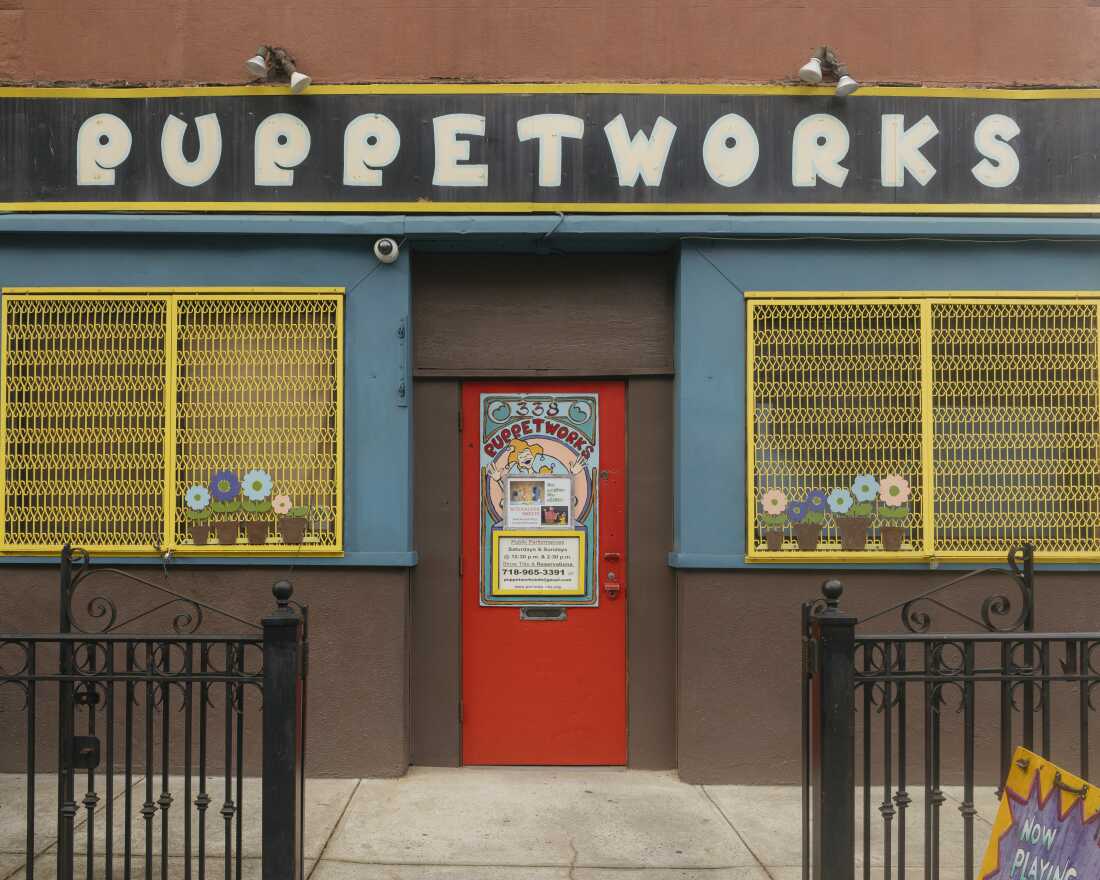
The Puppetworks theater in Brooklyn’s Park Slope neighborhood.
Anh Nguyen for NPR
hide caption
toggle caption
Anh Nguyen for NPR

A workshop station behind the stage at Puppetworks, where puppets are stored and repaired.
Anh Nguyen for NPR
hide caption
toggle caption
Anh Nguyen for NPR
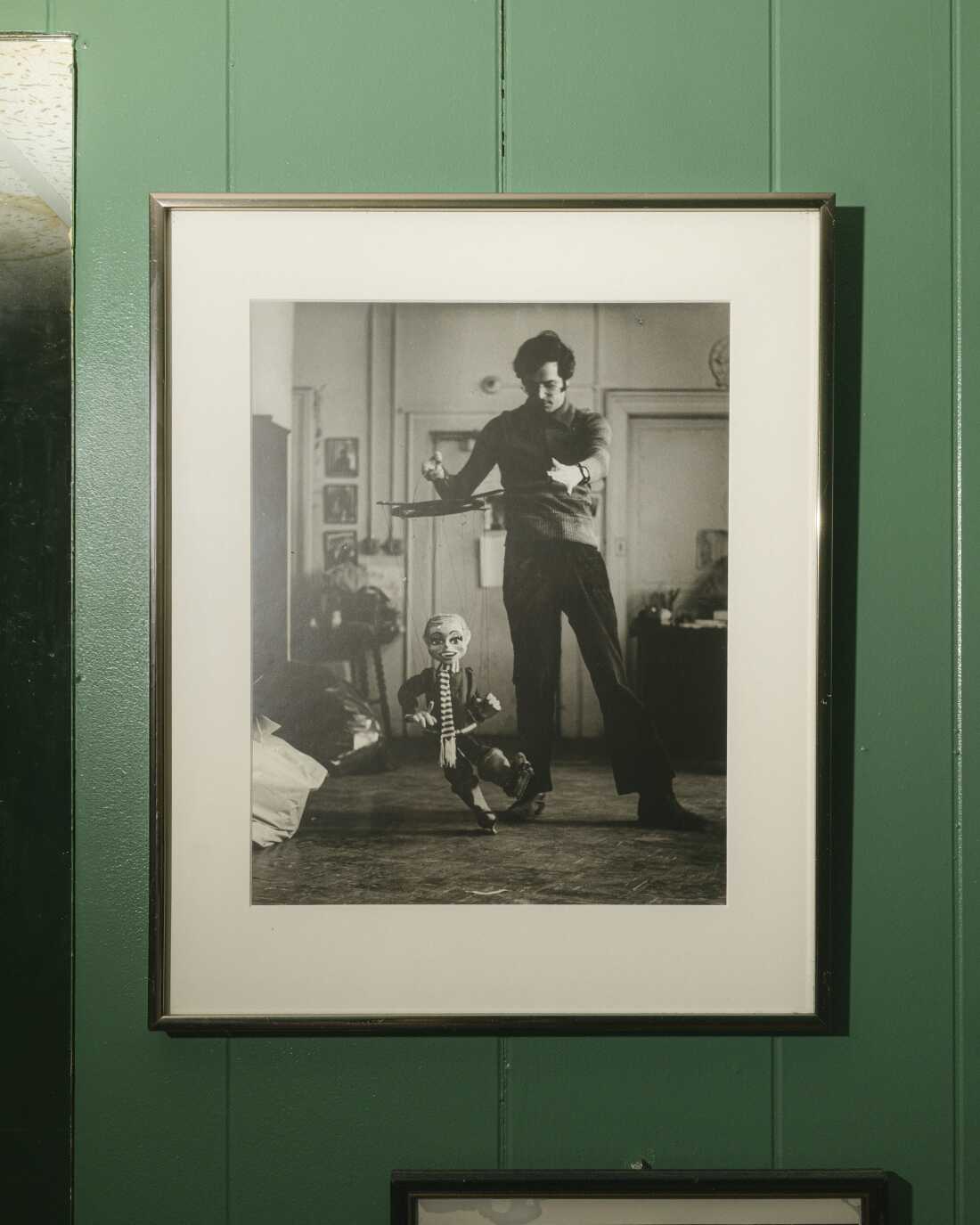
A picture of Nicolas Coppola, Puppetworks’ founder and artistic director, from 1970, in which he’s demonstrating an ice skater marionette puppet.
Anh Nguyen for NPR
hide caption
toggle caption
Anh Nguyen for NPR
For just $11 a seat ($12 for adults), puppets of all types — marionette, swing, hand and rod — take turns transporting patrons back to the ’80s, when most of Puppetworks’ puppets were made and the audio tracks were taped. Century-old stories are brought back to life. Some even with a modern twist.
Since Coppola started the theater, changes have been made to the theater’s repertoire of shows to better meet the cultural moment. The biggest change was the characterization of princesses in the ’60s and ’70s, Coppola says: “Now, we’re a little more enlightened.”

Right: Michael Jones, Puppetworks’ newest puppeteer, poses for a photo with Jack-a-Napes, one of the main characters in The Steadfast Tin Soldier. Left: A demonstration marionette puppet, used for showing children how movement and control works.
Anh Nguyen for NPR
hide caption
toggle caption
Anh Nguyen for NPR

Marionette puppets from previous Puppetworks shows hang on one of the theater’s walls.
Anh Nguyen for NPR
hide caption
toggle caption
Anh Nguyen for NPR

A child attends Puppetworks’ 12:30 p.m. showing on Saturday, Dec. 6, dressed in holiday attire that features the ballerina and tin soldier in The Steadfast Tin Soldier.
Anh Nguyen for NPR
hide caption
toggle caption
Anh Nguyen for NPR
Streaming has also influenced the theater’s selection of shows. Puppetworks recently brought back Rumpelstiltskin after the tale was repopularized following Dreamworks’ release of the Shrek film franchise.
Most of the parents in attendance find out about the theater through word of mouth or school visits, where Puppetworks’ team puts on shows throughout the week. Many say they take an interest in the establishment for its ability to peel their children away from screens.
Whitney Sprayberry was introduced to Puppetworks by her husband, who grew up in the neighborhood. “My husband and I are both artists, so we much prefer live entertainment. We allow screens, but are mindful of what we’re watching and how often.”

Left: Puppetworks’ current manager of stage operations, Jamie Moore, who joined the team in the early 2000s as a puppeteer, holds an otter hand puppet from their holiday show. Right: A Pinocchio mask hangs behind the ticket booth at Puppetworks’ entrance.
Anh Nguyen for NPR
hide caption
toggle caption
Anh Nguyen for NPR
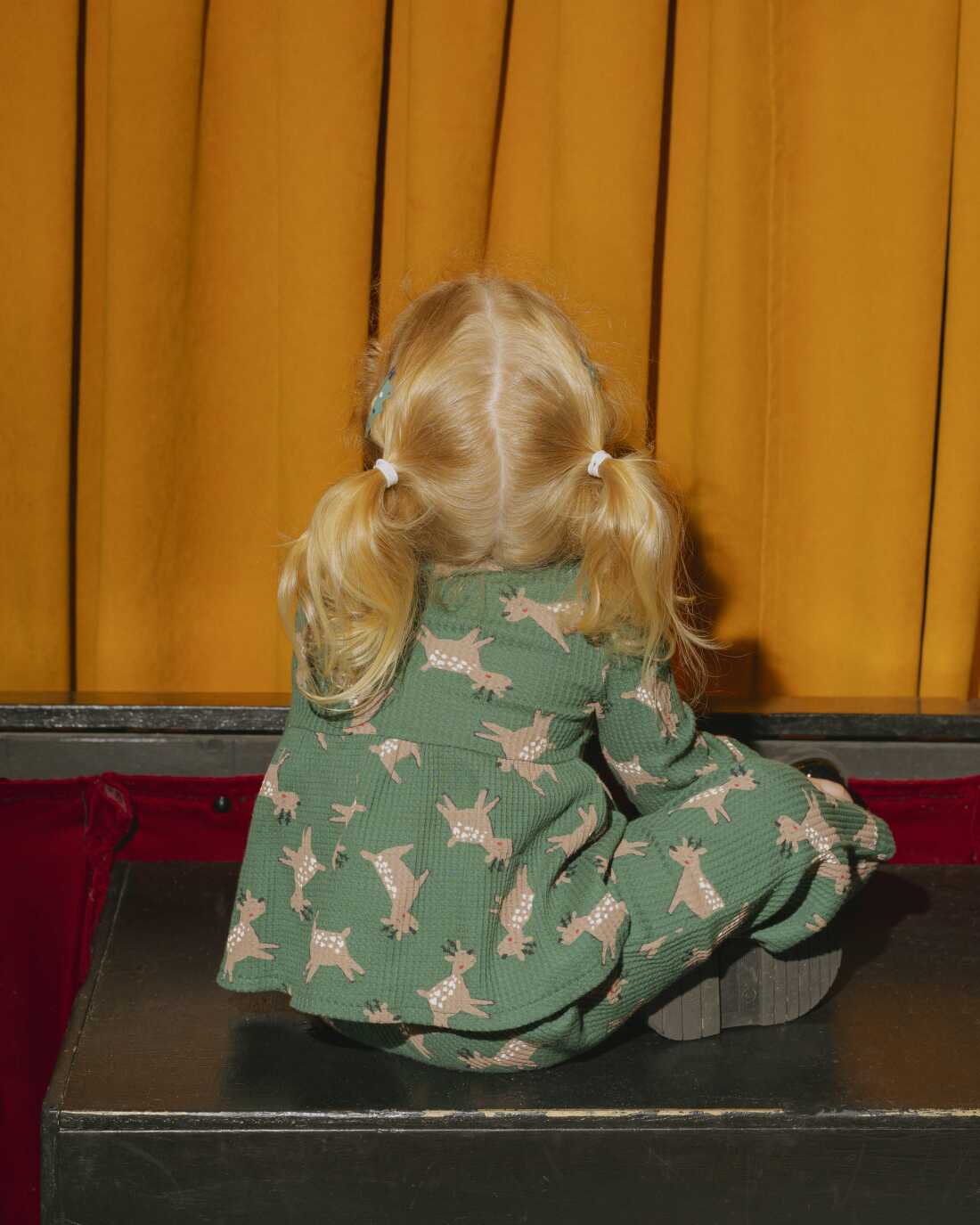
A child attends Puppetworks’ 12:30 p.m. showing on Saturday, Dec. 6, dressed in holiday attire.
Anh Nguyen for NPR
hide caption
toggle caption
Anh Nguyen for NPR

Left: Two gingerbread people, characters in one of Puppetworks’ holiday skits. Right: Ronny Wasserstrom, a swing puppeteer and one of Puppetworks’ first puppeteers, holds a “talking head” puppet he made, wearing matching shirts.
Anh Nguyen for NPR
hide caption
toggle caption
Anh Nguyen for NPR
Other parents in the audience say they found the theater through one of Ronny Wasserstrom’s shows. Wasserstrom, one of Puppetworks’ first puppeteers, regularly performs for free at a nearby park.
Coppola says he isn’t a Luddite — he’s fascinated by animation’s endless possibilities, but cautions of how it could limit a child’s imagination. “The part of theater they’re not getting by being on the phone is the sense of community. In our small way, we’re keeping that going.”

Puppetworks’ 12:30 p.m. showing of The Steadfast Tin Soldier and The Nutcracker Sweets on Saturday, Dec. 6.
Anh Nguyen for NPR
hide caption
toggle caption
Anh Nguyen for NPR
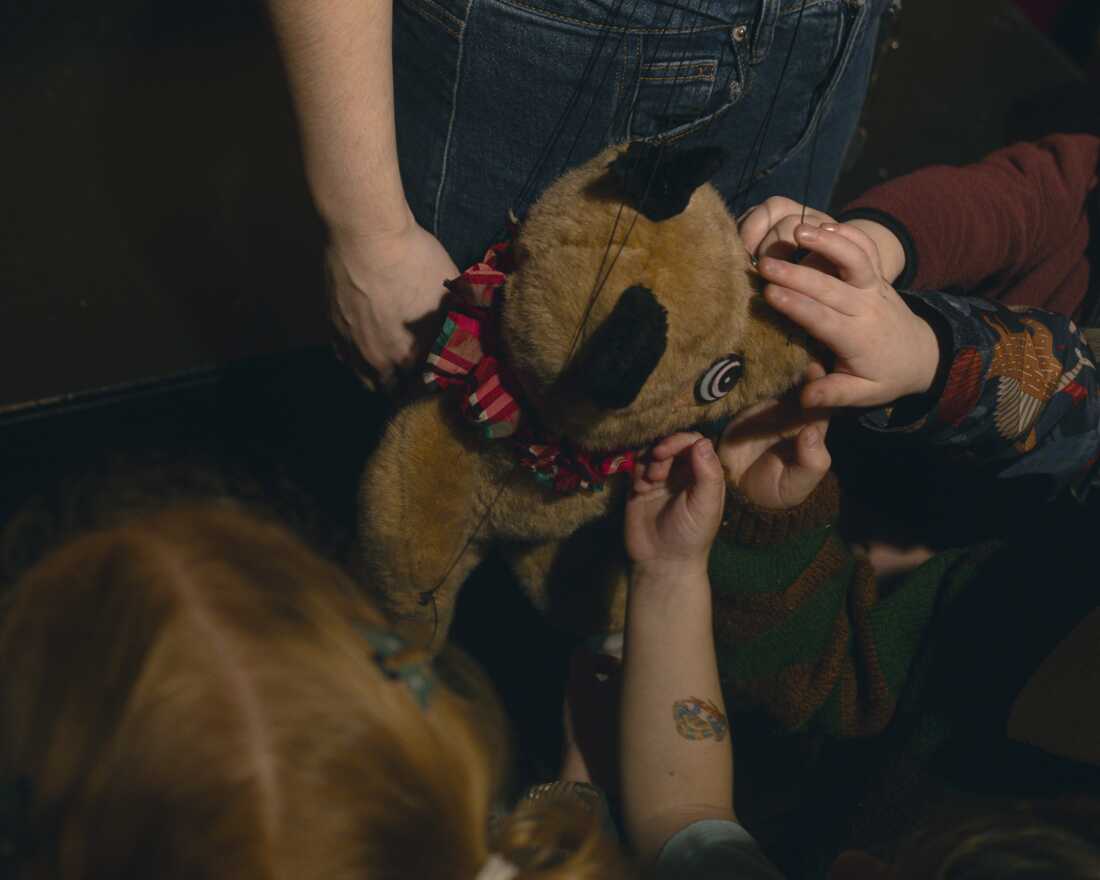
Children get a chance to see one of the puppets in The Steadfast Tin Soldier up close after a show.
Anh Nguyen for NPR
hide caption
toggle caption
Anh Nguyen for NPR
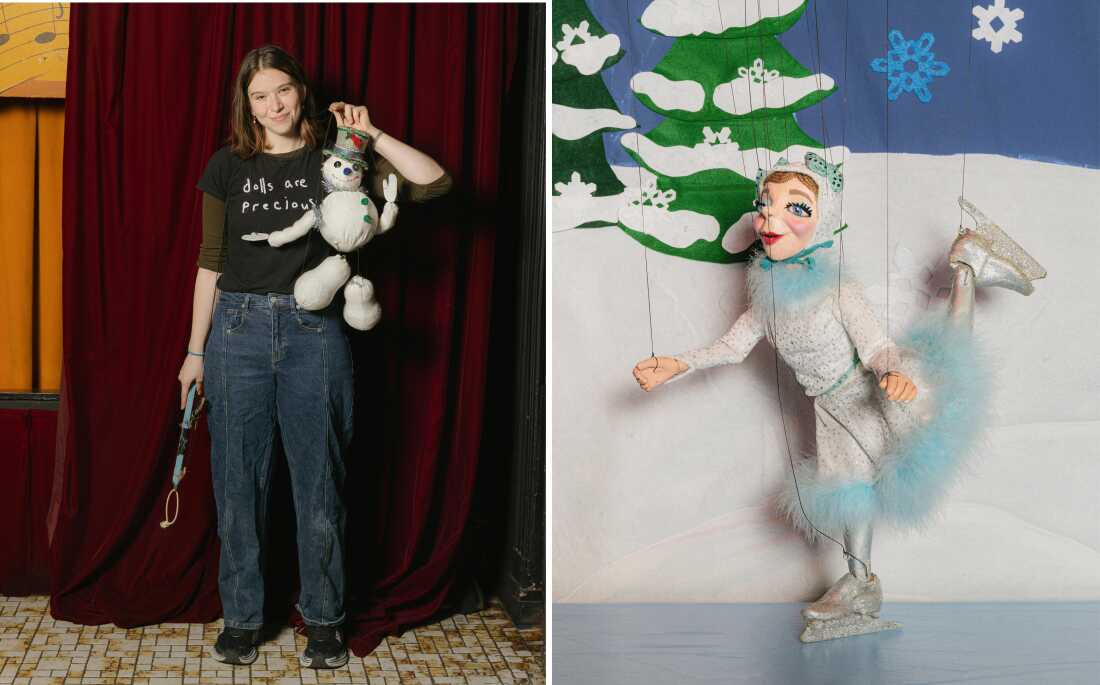
Left: Alyssa Parkhurst, Puppetworks’ youngest puppeteer, holds a snowman marionette puppet, a character in the theater’s holiday show. Right: An ice skater, a dancing character in one of Puppetworks’ holiday skits.
Anh Nguyen for NPR
hide caption
toggle caption
Anh Nguyen for NPR
Community is what keeps Sabrina Chap, the mother of 4-year-old Vida, a regular at Puppetworks. Every couple of weeks, when Puppetworks puts on a new show, she rallies a large group to attend. “It’s a way I connect all the parents in the neighborhood whose kids go to different schools,” she said. “A lot of these kids live within a block of each other.”

Three candy canes — dancing characters in one of Puppetworks’ holiday skits — wait to be repaired after a show.
Anh Nguyen for NPR
hide caption
toggle caption
Anh Nguyen for NPR
Anh Nguyen is a photographer based in Brooklyn, N.Y. You can see more of her work online, at nguyenminhanh.com , or on Instagram, at @minhanhnguyenn. Tiffany Ng is a tech and culture writer. Find more of her work on her website, breakfastatmyhouse.com.
Lifestyle
The Best of BoF 2025: Fashion’s Year of Designer Revamps

Lifestyle
Best Christmas gift I ever received : Pop Culture Happy Hour

-

 Iowa1 week ago
Iowa1 week agoAddy Brown motivated to step up in Audi Crooks’ absence vs. UNI
-

 Maine1 week ago
Maine1 week agoElementary-aged student killed in school bus crash in southern Maine
-

 Maryland1 week ago
Maryland1 week agoFrigid temperatures to start the week in Maryland
-

 New Mexico1 week ago
New Mexico1 week agoFamily clarifies why they believe missing New Mexico man is dead
-

 South Dakota1 week ago
South Dakota1 week agoNature: Snow in South Dakota
-

 Detroit, MI1 week ago
Detroit, MI1 week ago‘Love being a pedo’: Metro Detroit doctor, attorney, therapist accused in web of child porn chats
-

 Health1 week ago
Health1 week ago‘Aggressive’ new flu variant sweeps globe as doctors warn of severe symptoms
-

 Maine1 week ago
Maine1 week agoFamily in Maine host food pantry for deer | Hand Off

























